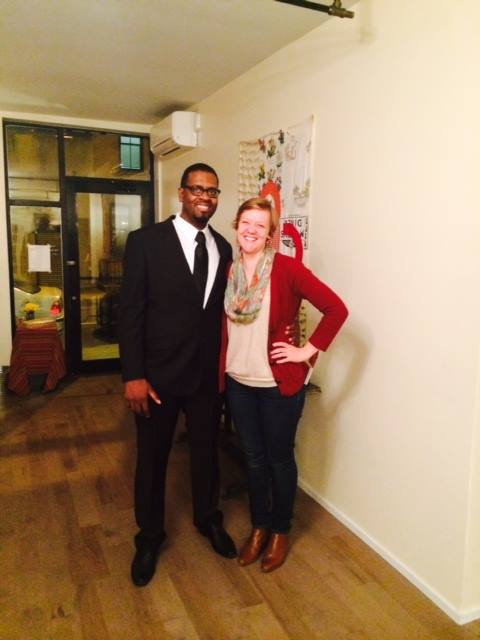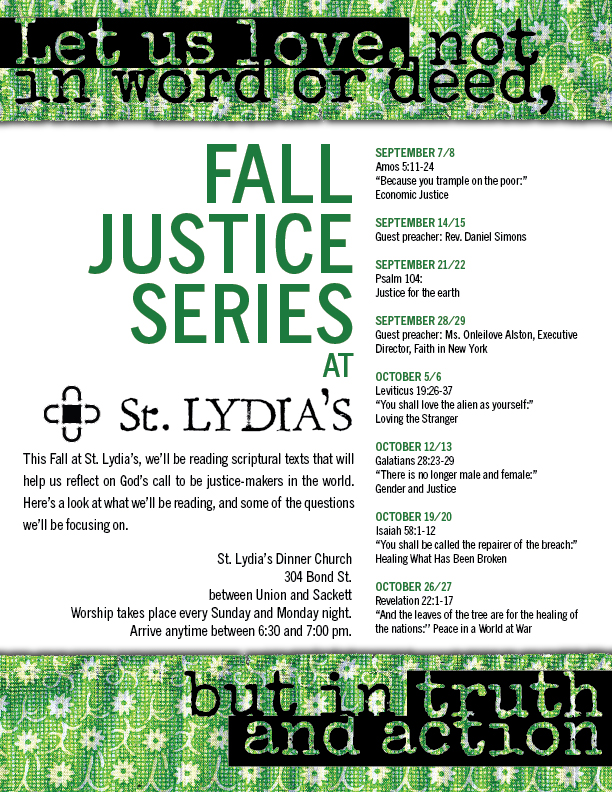November 4th, 2014
Squeezebox is a place for our Song Leaders, as well as congregants, to learn the songs we sing at St. Lydia’s.
Here’s all the music you’ll need for the Advent Season at St. Lydia’s this year. Advent is usually a four week season that leads into Christmas, but we’re reclaiming an earlier tradition of a seven week Advent. This will give us a little more time to settle into the themes of beginning and ending, expectation, hope and waiting.
Gathering Song
Come O Lord And Set Us Free, from the Iona Community in Scotland
or
Come Now, O Prince of Peace, with text and music by Geonyong Lee. Sheet music is here! Please note that if the silver setting is too low for you, you can sing this one on blue as well.
Candle Lighting Song
Each week of Advent, we’ll chant, call and response, a verse of O Come O Come Emmanuel. We’ll start by singing the verse call and response, then sing it again overlapping. Each time the refrain comes around, bring in the whole congregation together, without call and response!
Table Acclamation
The Vasile Advent Table Acclamation. This one is all kinds of bluesy, and Paul Vasile wrote it just for us!
Prayer Song
Song Leader’s choice. A selection of songs may be found here.
Offering Song (After Clean Up)
Laudate Dominum (or, “Sing Praise and Bless the Lord,), from the Taize Community in France. Sheet music may be found here.
Final Hymn
In November we’ll sing Lo, How A Rose E’er Blooming, and in December we’ll sing St. Lydia’s favorite, People Look East.
October 24th, 2014

Anthony (l) and Emily (r) at St. Lydia's on October 20, 2014.
Anthony Sandusky, friend of St. Lydia’s and a pastor at Concord Baptist Church in Bed-Stuy, Brooklyn stopped by last week to preach on Isaiah 58:1-12 and the prison industrial complex in America. Crucial to our understanding of incarceration in our country is our grappling with the fact that racism is at its heart. Here is a short list of resources for further reading–a place to start:
The New Jim Crow, Michelle Alexander
Black Pain, Terrie Williams
The Souls of Black Folk, W.E.B. DuBois
The Miseducation of the Negro, Carter G. Woodson
The Condemnation of Blackness, Khalil Gibran Muhammad
White Like Me, Tim Wise
Dear White America, Tim Wise
Websites
www.realcostofprisons.org
October 9th, 2014
One Sunday, September 28, St. Lydia’s was pleased to welcome Onleilove Alton, Executive Director of Faith in New York to preach at our service. Onleilove asked the question, “Who is my neighbor,” through the lens of the story of the Good Samaritan, found in the Gospel of Luke. We were privileged to hear Onleilove’s reflection on neighborhood, gentrification, and the work of Faith in New York.
Building Beloved Community in Brooklyn: Who Is My Neighbor?
Onleilove Alston
Reflection on Scripture
The interesting thing about the Good Samaritan parable is that we find a Lawyer trying to find a loophole in Jesus’ teaching, so I guess after 2,000 years some things never change. But on a serious note things actually haven’t changed a great deal from Jesus’ day to today when it comes to the concept of neighbor. We find a story where someone has fallen on hard times in a community and those who should respond — our religious leaders, the good respectable people those who are like many of us sitting here on a Sunday night — did not respond to crisis in a way that was in line with their spiritual beliefs.
To truly understand the radical lesson of this story we have to examine the Samaritan who was marginalized in the culture because he was not fully Jew or Gentile yet lived out the Jewish faith in a practical way by responding to crisis and not looking the other way. Today when people don’t fit into our neat boxes we place them on the margins: the biracial person who defies our expectations of race, the poor person who is empowered and does not need our saving but partnership, the woman who feels called to ministry. What does it mean to live in community where things are no longer black vs. white but multicultural, rich vs. poor, but now middle class, as people can’t afford the rent in New York City? How do we love our neighbor when in Brooklyn and New York City in general our neighbors are changing rapidly and constantly? Who is our neighbor? Do we even want to know our neighbors and do our neighbors want to know us?
As people of faith in Brooklyn what does it mean to love your neighbor when the borough is facing real changes and we are a part of those changes? Does love mean guilt, anger, patronizing service-all of the above or does love mean finding a way to do the messiness of community together, being like the Good Samaritan and interrupting our day to have a radically different response to your neighbor-a response that goes against what the culture says you will do? As someone who was born and raised in Brooklyn (a rare breed) I don’t think the borough is in crisis because newer, younger residents are moving in, I think our borough is in crisis because as this city is developed without input from its residents we are losing neighborhoods and thus we are losing the ability to love our neighbor. Change is inevitable and so Brooklyn will always be in a state of change, but can we as people of faith in the borough help shape this change in a way that benefits old AND new Brooklynites?
My Story
For me this question of loving my neighbor as my self is deeply tied to the concept of home. Home is very important to me because at the age of seven when my step-father lost his job, my family lost our home. Like so many families in the 80’s we ended up homeless and in New York’s shelter system. For me being homeless meant losing your ability to be in community. Eventually my little brother and I went into the foster care system and ended up with my grandmother who lived in public housing in East New York. Though many look down on this neighborhood, after a year of trauma I was extremely happy to be back home where I was born. To me East New York doesn’t just represent statistics but family, friends and community. Most often we see New York City through the eyes of statistics, film, television and what the trend makers say, but what if we saw our borough with new eyes and began see all the neighborhoods and thus all our neighbors as valuable?
Guilt, Anger or Faithful Action:
Faith in New York’s Building the Beloved City & Real Affordability for All Campaign
We all know that the elephant in the room of Brooklyn is gentrification. This word is very emotionally charged for people on all sides. Some feel guilty and some feel angry about the changes happening in Brooklyn, yet often neither side understands the forces driving change in our Borough: international developers who can build in New York with twenty year tax-breaks without community investment. The rising cost of higher education causes young adults to start life with crippling debt. Re-zoning plans that to date have not included community input. Systematic racism that caused African-American and Latino families to be given sub-prime loans that are now leading to foreclosures.
Instead of a crisis of gentrification, is what we really have a crisis of knowing and loving our neighbor? Guilt and anger have their limits, but as people of faith we can develop a third way of reacting to community change. Faith in New York has discerned that we need to address the issue of affordable housing and development because all of our member congregations — Christian, Jewish, Catholic, Black, White, Latino — are frustrated at issues related to housing: rising rents and foreclosures. In Astoria, Msgr. Ferrarsse, a Catholic Priest who sits on our board, is frustrated that the neighborhood is disappearing. At first glance these seem like policy issues, but when we examine the situation we see that this is a moral crisis that challenges us to ask, “who is my neighbor?” and, “how do I love my neighbor in a city where corporate development matters more than community?”
Faith in New York is a part of the Real Affordability for All Coalition, with community and housing advocacy groups to serve as a witness that people of faith don’t just want to talk about loving our neighbor, but that we want to take action to make sure our neighbors can afford to live in this city. Is there a way that old AND new Brooklyn can live together in Beloved Community? Well according to Bell Hooks yes, because in her words “Beloved community is formed not by the eradication of difference but by its affirmation, by each of us claiming the identities and cultural legacies that shape who we are and how we live in the world.”
Go and do the same: Action Steps
I’m a community organizer, and so I can’t resist ending with some concrete actions steps. Here are some ways you might find to build the beloved community in your context:
1. Invest in the community you live in, regardless of how long you will be here.
2. Get to know your neighbors and listen to their pain.
3. Be a bridge builder.
4. See the community assets as opposed to the stereotypical deficits. The Samaritan was seen as less than because he was not fully Hebrew, but in God’s eyes he was the most compassionate, heroic neighbor. Though some neighborhoods in Brooklyn may appear to be lacking, they may actually have gifts that our eyes are trained to miss.
5. Prayerfully build community at St. Lydia’s, at your job and in your home, practice being a neighbor.
6. On Sunday October 5th from 2-6pm Faith in New York is hosting an Affordable Housing for All Training at St. Paul Apostle Church. If you want to learn more about what your congregation can do in partnership with people of faith and housing advocates from across NYC come to help the city provide real affordable housing for all of us join us and feel free to leave early to make it to service.
God is not just in the Sunday service but in how we deal with the practical difficulties of life as we journey down our own Jericho Road.
September 4th, 2014
Squeezebox is a place for our Song Leaders, as well as congregants, to learn the songs we sing at St. Lydia’s.
Songs for September and October, 2014 are here! These songs have been selected to reflect our Fall Series on justice. And! The wonderful Paul Vasile and Jake Slichter will be helping us learn them at a song leading workshop this September 28, so stay tuned.
Gathering Song
“Liberate Us,” South Africa
“Freedom Come,” Ben Allaway
Candle Lighting Song
“Lead Me, Guide Me,” Doris Akers
“Christ is Our Guiding Light,” Eric Law
Acclamation
Ordinary Time Acclamation, Emily Scott
Prayer Song
Song Leader’s choice, options are here
Offering Song
(this is the re-gathering song after clean up, which will also be our time of offering)
“Gloria, Alleluia,” Marilyn Haskel
Note: the recording starts at the very beginning of the song — in just cuts in a tiny bit late. When we sing this for offering song, I’d suggest the song leader and drummer beginning with the handclap pattern and adding the melody from there.
Final Hymn
September: I Come With Joy, look here, recording to come
October: Joyous Light of Heavenly Glory, to come



